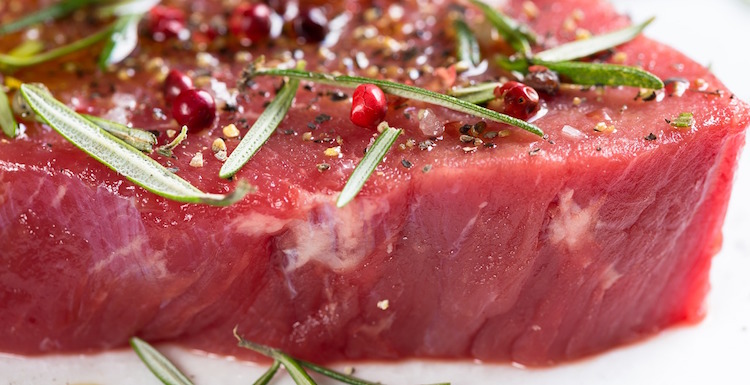Eat your bodyweight in grams of protein per day.
For athletes, that’s often the recommendation. So, if you’re 150 lb., you should eat 150 grams of protein each day.
Turns out, it’s not quite that simple. Why? Because all protein isn’t created equal.
While a 3 oz. piece of beef has essentially the same number of grams of protein as 5 Tbsp. of peanut butter, what your body does with these two proteins is not the same. (And in this case, 5 Tbsp. of peanut butter has roughly three times the number of calories as 3 oz. of beef).
It comes down to the DIAAS score of the protein, which stands for digestible indispensable amino acid score.
Bear with me for a second while I give you the formula for calculating DIAAS:
DIASS % = 100 x [(mg of digestible dietary indispensable amino acid in 1 g of the dietary protein) / (mg of the same dietary indispensable amino acid in 1 g of the reference protein)].
Indispensable amino acid is another term for essential amino acid, which you might have heard of before. These indispensable amino acids include alanine, asparagine, aspartic acid, cysteine, glutamic acid, glutamine, glycine, proline, serine and tyrosine. Your body can’t make essential amino acids on its own, so they have to come from your diet.
While you can certainly dig deeper into this stuff (1), these are the nuts and bolts:
- The DIASS score looks at both the amino acid profile of the protein, as well as its bioavailability, meaning how well your body both digests and absorbs the protein.
- As a general rule, animal-based proteins have much higher DIAAS scores than plant-based proteins.
As Chris Kresser— the co-director of the California Center for Functional Medicine, founder of Kresser Institute and the New York Times best selling author of The Paleo Cure—explained on the Joe Rogan podcast, rare beef has one of the highest DIAAS scores, while wheat has one of the lowest.
Some numbers Kresser gave on the podcast include:
Rare beef: 1.39 (or 139 percent)
Eggs: 1.13 (or 113 percent)
Peanut butter: 0.45 (or 45 percent)
Wheat: 0.2 (or 20 percent)
Generally speaking, plant proteins and grains have DIAAS values of less than 75 percent, although soy protein sits between 75 to 100 percent, and oats at approximately 75 percent (2). Animal protein—be it milk products, beef, pork etc—tend to have DIAAS scores of 100 percent or higher (3).
What do those numbers mean?
Essentially, if a protein has a DIAAS score of 75 to 99 percent, it is considered good, while a score of 100 percent or above is considered an excellent source of protein, again based its amino acid profile and your body’s ability to digest and absorb it.
So if the DIAAS score is lower, you can still get all of the essential amino acids, but you’ll need to eat a whole lot more of them to have the same effect as consuming protein with a higher bioavailability.
If you’re not a huge meat eater, or are 100 percent plant-based, consider these 5 tips for maximizing absorption:
1. Tempeh over tofu
Not only is tempeh less processed than tofu, it is also easier to digest and absorb because of its fermented nature.
2. Oats
Oats have more protein than you might think—17 grams of protein per 100 gram serving. And it has a DIAAS score of around 75 percent, so while not perfect, oats are much better than many other plant-based proteins.
3. Acidic foods
Eating acidic foods have been shown to improve protein absorption, because the acid helps break the bonds that hold the amino acids in the protein, which allows you to absorb it more effectively. So consider eating more apple cider vinegar and lemons.
4. Vitamin B6
Make sure you’re getting enough Vitamin B6. Its main purpose is to help break protein down so you can absorb the amino acids into your bloodstream. Vegetables such as carrots, spinach and sweet potato have high levels of Vitamin B6.
5. Chew your food
Chewing your food more is a simple way to improve digestion and absorption, not just of protein, but in general. This University of California Davis study (4) found that chewing almonds longer led to improved digestion. So slow down and chew.
References
1. Wolfe, Robert R. et al. Protein quality as determined by the Digestible Indispensable Amino Acid Score: evaluation of factors underlying the calculation. Nutrition Reviews. 2016.
2. Bailey, Hannah M, Stein, Hans H. Can the digestible indispensable amino acid score methodology decrease protein malnutrition. Oxford Academic. October 2019.
3. Bailey, Hannah Marie. Digestible Indispensable Amino Acid Score for Meat Products. Thesis submitted to the University of Illinois at Urbana-Champaign. 2018.
4. Cassady, Bridget A et al. Mastication of almonds: effects of lipid bioaccessibility, appetite, and hormone response. The American Journal of Clinical Nutrition. 2009.
